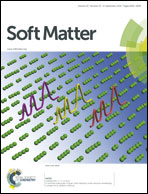Chain flexibility for tuning effective interactions in blends of polymers and polymer-grafted nanoparticles
Abstract
We present molecular dynamics simulations of polymer-grafted nanoparticles in a homopolymer matrix to demonstrate the effect of chain flexibility on the potential of mean force (PMF) between various species in the nanocomposite. For a relatively high grafting density of Σg = 0.76 chains/σp2 (where σp is the polymer monomer diameter), when the brush chain length is significantly smaller than (<∼1/4) the matrix chain length, the brushes exhibit autophobic dewetting with matrix polymers resulting in a strong attractive well in the particle–particle PMF. As the chain flexibility is decreased, we observe significant changes in particle–particle and particle–matrix PMFs that are strongly coupled with the length (or molecular weight) of grafted chains. For low molecular weight grafted chains, the change in the well-depth of particle–particle PMFs, with increasing chain stiffness, is non-monotonous, while that for longer grafted chains (still shorter than matrix chains), the attractive well exhibits a monotonous decrease in its depth. The particle–matrix PMF and the matrix penetration depth into the brush layer indicate that wetting of the grafted layer by matrix chains is enhanced with increasing chain stiffness.


 Please wait while we load your content...
Please wait while we load your content...